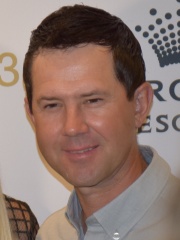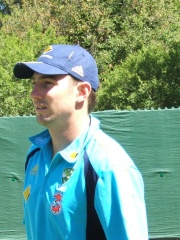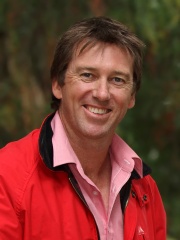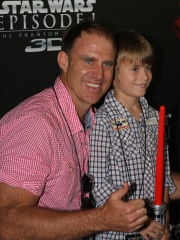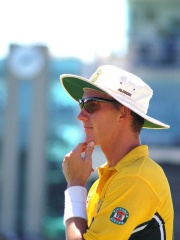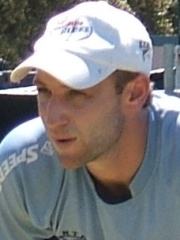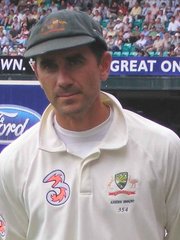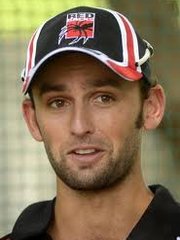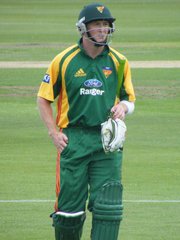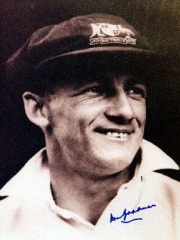
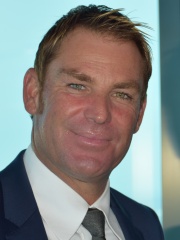
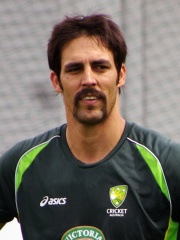
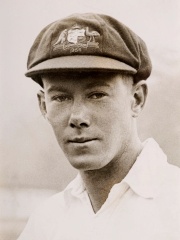
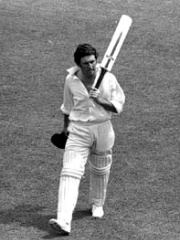

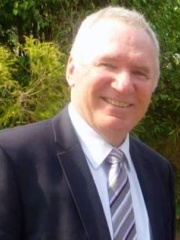
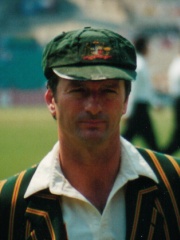
The Most Famous
CRICKETERS from Australia
This page contains a list of the greatest Australian Cricketers. The pantheon dataset contains 136 Cricketers, 25 of which were born in Australia. This makes Australia the birth place of the 2nd most number of Cricketers.
Top 10
The following people are considered by Pantheon to be the top 10 most legendary Australian Cricketers of all time. This list of famous Australian Cricketers is sorted by HPI (Historical Popularity Index), a metric that aggregates information on a biography's online popularity. Visit the rankings page to view the entire list of Australian Cricketers.

1. Don Bradman (1908 - 2001)
With an HPI of 74.98, Don Bradman is the most famous Australian Cricketer. His biography has been translated into 54 different languages on wikipedia.
Sir Donald George Bradman (27 August 1908 – 25 February 2001), nicknamed "The Don", was an Australian international cricketer, widely acknowledged as the greatest batsman of all time. His cricketing successes have been claimed by Shane Warne, among others, to make Bradman the "greatest sportsperson" in history. Bradman's career Test batting average of 99.94 is considered by some to be the greatest achievement by any sportsman in any major sport. The story that the young Bradman practised alone with a cricket stump and a golf ball is part of Australian folklore. His meteoric rise from bush cricket to the Australian Test team took just over two years. Before his 22nd birthday, he had set many records for top-scoring, some of which still stand, and became Australia's sporting idol at the height of the Great Depression. This hero status grew and continued through the Second World War. During a 20-year playing career, Bradman consistently scored at a level that made him, in the words of former Australia captain Bill Woodfull, "worth three batsmen to Australia". A controversial set of tactics, known as Bodyline, was specially devised by the England team to curb his scoring. As a captain and administrator, Bradman was committed to attacking, entertaining cricket; he drew spectators in record numbers. He hated the constant adulation, however, and it affected how he dealt with others. The focus of attention on Bradman's individual performances strained relationships with some teammates, administrators and journalists, who thought him aloof and wary. Following an enforced hiatus due to the Second World War, he made a dramatic comeback, captaining an Australian team known as "The Invincibles" on a record-breaking unbeaten tour of England. A complex and highly driven man, not given to close personal relationships, Bradman retained a pre-eminent position in the game by acting as an administrator, selector and writer for three decades following his retirement. Even after he became reclusive in his declining years, Bradman's opinion was highly sought, and his status as a national icon was still recognised. Almost fifty years after his retirement as a Test player, in 1997, Prime Minister John Howard called him the "greatest living Australian". Bradman's image has appeared on postage stamps and coins, and a museum dedicated to his life was opened while he was still living. On the centenary of his birth, 27 August 2008, the Royal Australian Mint issued a $5 commemorative gold coin with Bradman's image. In 2009, he was inducted posthumously as an inaugural member into the ICC Cricket Hall of Fame.

2. Shane Warne (1969 - 2022)
With an HPI of 47.73, Shane Warne is the 2nd most famous Australian Cricketer. His biography has been translated into 42 different languages.
Shane Keith Warne (13 September 1969 – 4 March 2022) was an Australian international cricketer whose career ran from 1992 to 2007. Warne played as a right-arm leg spin bowler and a lower-order right-handed batter for Victoria, Hampshire, the Melbourne Stars and Australia. Warne also played for and coached the Rajasthan Royals, including captaining the team to victory in the inaugural season of the IPL. He made 145 Test appearances, taking 708 wickets, and set the record for the most wickets taken by any bowler in Test cricket, a record he held until 2007. Warne was a useful lower-order batsman who scored more than 3,000 Test runs, with a highest score of 99. Warne was a member of the Australian team that won the 1999 Cricket World Cup. He retired from international cricket at the end of Australia's 2006–07 Ashes series victory over England. Warne revolutionised cricket thinking with his mastery of leg spin, then regarded as a dying art. After retirement, he regularly worked as a cricket commentator and for charities and endorsed commercial products. During his career, Warne was involved in off-field scandals including a ban from cricket for testing positive for a prohibited substance, a colourful personal life and interactions with gambling figures. Warne died suddenly of a heart attack at the age of 52, while on holiday in Thailand. After his death, many tributes and memorials were made to Warne, both in his home city of Melbourne and elsewhere in the cricketing world. Warne was posthumously appointed an Officer of the Order of Australia (AO) for his service to cricket.

3. Mitchell Johnson (b. 1981)
With an HPI of 44.79, Mitchell Johnson is the 3rd most famous Australian Cricketer. His biography has been translated into 20 different languages.
Mitchell Guy Johnson (born 2 November 1981) is an Australian former cricketer, who played all forms of the game for his national side. He is a left-arm fast bowler and left-handed batsman. He represented Australia in international cricket from 2005 to 2015. Johnson is considered to be one of the greatest fast bowlers of his era. With his time representing Australia, Johnson won multiple ICC titles with the team: the 2007 Cricket World Cup, the 2015 Cricket World Cup, the 2006 ICC Champions Trophy, and the 2009 ICC Champions Trophy. Johnson was awarded the International Cricket Council's Sir Garfield Sobers Trophy (ICC Cricketer of the Year) in 2009. After suffering a drop in form that led to his removal from the national side in early 2013, he was particularly successful in his 'comeback' to the Australian Test squad during the 2013–14 Ashes series in Australia, during which he dominated England's batting. He cemented his place in the Australian side in the following Test series against South Africa and was rewarded with his second Sir Garfield Sobers Trophy and first ICC Test Player of the Year award in 2014. He played a key role in the semi-final and final matches of the 2015 World Cup, which ultimately culminated in Australia winning the World Cup for the fifth time. Johnson retired from all forms of international cricket in November 2015, having represented Australia in a total of 256 matches. He was the last active Australian player with a Test cap number in the 300s. In terms of time span, Johnson is also the quickest bowler to reach 150 Test wickets, doing so in 2 years and 139 days. In August 2018, Johnson announced his retirement from all forms of cricket.

4. Bill Brown (1912 - 2008)
With an HPI of 43.82, Bill Brown is the 4th most famous Australian Cricketer. His biography has been translated into 16 different languages.
William Alfred Brown, (31 July 1912 – 16 March 2008) was an Australian cricketer who played 22 Test matches between 1934 and 1948, captaining his country in one Test. A right-handed opening batsman, his partnership with Jack Fingleton in the 1930s is regarded as one of the finest in Australian Test history. After the interruption of World War II, Brown was a member of the team dubbed "The Invincibles", who toured England in 1948 without defeat under the leadership of Don Bradman. In a match in November 1947, Brown was the unwitting victim of the first instance of "Mankading". Raised in New South Wales, Brown initially struggled in both work and cricket, before gradually rising through the cricket ranks. He made his first-class debut for New South Wales in the 1932–33 season and forced his way into the national side during the 1934 tour of England. When long-term openers Bill Ponsford and Bill Woodfull retired at the end of the tour, Brown and his state opening partner Fingleton took over. After poor form made his selection for the 1938 tour of England controversial, Brown responded with a total of 1,854 runs, including an unbeaten 206 that saved Australia from defeat in the Second Test, and was honoured as one of the five Wisden Cricketers of the Year. The outbreak of the Second World War cost Brown his peak years, which he spent in the Royal Australian Air Force. Cricket resumed in 1945–46 and Brown, in Bradman's absence, captained an Australian eleven in a match that was retrospectively awarded Test status. Brown missed the entirety of the following season because of injury. Upon his return, he was unable to repeat his previous success and was ousted from the opening positions by Arthur Morris and Sid Barnes. Selected for the Invincibles tour, he performed reasonably well in the tour matches but, with Morris and Barnes entrenched as openers, he batted out of position in the middle order during the first two Tests. He struggled and was dropped from the Test team, never to return. Upon returning to Australia, Brown continued playing for Queensland until the end of the 1949–50 season. In retirement, Brown briefly served as a Test selector and sold cars and, later, sports goods. In 2000, he was awarded the Medal of the Order of Australia for his services to cricket. At the time of his death in 2008, he was Australia's oldest Test cricketer.
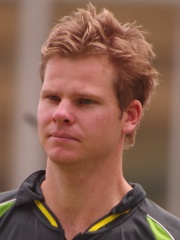
5. Steve Smith (b. 1989)
With an HPI of 43.58, Steve Smith is the 5th most famous Australian Cricketer. His biography has been translated into 23 different languages.
Steven Peter Devereux Smith (born 2 June 1989) is an Australian international cricketer, former captain of the Australian national team in all three formats of the game and since 2021, the vice-captain of the Australian Test team. He is regarded as the best Test batsman of his generation, scoring over 10,000 Test runs and one of the greatest of all time, having reached an ICC Test batting rating of 947, the second-highest figure of all time, only behind Don Bradman's 961 and was named ICC Men's Test Player of the Decade for 2011–2020. Although he was initially selected for Australia as a leg-spinning all-rounder in all formats in 2010, Smith was always earmarked as a batting prospect following successful batting campaigns in domestic cricket early in his career. After playing five Test matches from 2010 to 2011 as a bowling all-rounder, he was recalled to the Australian Test team in 2013 as a batsman and took over the captaincy from Michael Clarke in late 2015. Smith now plays primarily as a batsman, and has predominantly batted at number 4 in Test cricket and number 3 in ODIs and T20Is. Awards he has won include the Sir Garfield Sobers Trophy (ICC Cricketer of the Year) in 2015; ICC Test Player of the Year in 2015 and 2017; ICC Men's Test Player of the Decade for 2011–2020; the Allan Border Medal for the best player in Australian Cricket in 2015, 2018, 2021 and 2023; Australian Test Player of the Year in 2015 and 2018, and Australian One Day International Player of the Year in 2015 and 2021. He was named by Wisden as one of their Cricketers of the Year in the 2016 Wisden Almanack. In December 2017, Smith reached an ICC Test batting rating of 947, the second-highest figure of all time, only behind Don Bradman's 961. In March 2018, Smith as Australian captain was widely criticised for the ball tampering incident which occurred in the third Test against South Africa. During the Test, Smith stood down from the team captaincy following immediate backlash and was replaced by Tim Paine. Following an investigation by Cricket Australia, Smith was banned from all international and domestic cricket in Australia for one year, and from consideration for any leadership role for an additional year. In November 2021, Smith returned to an official Australian leadership role, as Test vice-captain starting in the 2021–22 Ashes series. In December 2021, Smith returned to Test captaincy duties when Pat Cummins was unavailable due to COVID-19 for the 2nd Test. He has since captained in 6 Tests for 5 wins and a draw, including Australia's only Test victory in India since 2017 when he was captain. In March 2023, Smith returned to ODI captaincy duties, he went on to captain another 13 ODIs, winning the 2022–23 ODI series vs India, the 2023–24 ODI series vs West Indies and the 2024 ODI series v England and captaining Australia in the 2025 ICC Champions Trophy. He retired from ODI cricket on 5 March 2025, leading Australia in his last ODI as captain. Smith was a core member of the Australian white-ball teams that won the 2015 ICC Cricket World Cup, 2021 ICC Men's T20 World Cup and the 2023 ICC Cricket World Cup and was vice-captain of the Australia Test team that won the 2021–23 ICC World Test Championship.

6. Ian Chappell (b. 1943)
With an HPI of 41.97, Ian Chappell is the 6th most famous Australian Cricketer. His biography has been translated into 15 different languages.
Ian Michael Chappell (born 26 September 1943) is a former cricketer who played for South Australia and Australia. Known as "Chappelli", he is considered as one of the greatest captains the game has seen. He captained Australia between 1971 and 1975 before taking a central role in the breakaway World Series Cricket organisation. Born into a cricketing family—his grandfather and brother also captained Australia—Chappell made a hesitant start to international cricket playing as a right-hand middle-order batsman and spin bowler. He found his niche when promoted to bat at number three. Chappell's blunt verbal manner led to a series of confrontations with opposition players and cricket administrators; the issue of sledging first arose during his tenure as captain, and he was a driving force behind the professionalisation of Australian cricket in the 1970s. He was the captain of the Australian squad which finished as runners-up at the 1975 Cricket World Cup. John Arlott called him "a cricketer of effect rather than the graces". An animated presence at the batting crease, he constantly adjusted his equipment and clothing, and restlessly tapped his bat on the ground as the bowler ran in. Basing his game on a sound defence learned during many hours of childhood lessons, Chappell employed the drive and square cut to full effect. He had an idiosyncratic method of playing back and across to a ball of full length and driving wide of mid-on, but his trademark shot was the hook, saying "three bouncers an over should be worth 12 runs to me". A specialist slip fielder, he was the fourth player to take one hundred Test catches. Since his retirement in 1980, he has pursued a high-profile career as a sports journalist and cricket commentator, predominantly with Channel Nine. He remains a key figure in Australian cricket: in 2006, Shane Warne called Chappell the biggest influence on his career. Chappell was inducted into the Sport Australia Hall of Fame in 1986, the FICA Cricket Hall of Fame in 2000 and the Australian Cricket Hall of Fame in 2003. On 9 July 2009, Ian Chappell was inducted into the ICC Cricket Hall of Fame.

7. Richie Benaud (1930 - 2015)
With an HPI of 41.82, Richie Benaud is the 7th most famous Australian Cricketer. His biography has been translated into 15 different languages.
Richard Benaud (; 6 October 1930 – 10 April 2015) was an Australian cricketer who played for New South Wales and Australia. Following his retirement from international cricket in 1964, Benaud became a highly regarded commentator on the game. Benaud was a Test cricket all-rounder, blending leg spin bowling with lower-order batting aggression. Along with fellow bowling all-rounder Alan Davidson, he helped restore Australia to the top of world cricket in the late 1950s and early 1960s after a slump in the early 1950s. In 1958, he became Australia's Test captain until his retirement in 1964. He became the first player to reach 200 wickets and 2,000 runs in Test cricket, reaching the milestone in 1963. Gideon Haigh described him as "perhaps the most influential cricketer and cricket personality since the Second World War." In his review of Benaud's autobiography Anything But, Sri Lankan cricket writer Harold de Andrado wrote: "Richie Benaud possibly next to Sir Don Bradman has been one of the greatest cricketing personalities as player, researcher, writer, critic, author, organiser, adviser and student of the game."

8. Allan Border (b. 1955)
With an HPI of 41.77, Allan Border is the 8th most famous Australian Cricketer. His biography has been translated into 17 different languages.
Allan Robert Border (born 27 July 1955) is an Australian cricket commentator and former international cricketer. A batsman, Border was for many years the captain of the Australian team, and led his team to victory in the 1987 Cricket World Cup, the maiden world title for Australia. His playing nickname was "A.B.". He played 156 Test matches in his career, a record until it was passed by fellow Australian Steve Waugh. Border formerly held the world record for the number of consecutive Test appearances of 153, before it was surpassed in June 2018 by Alastair Cook, and is second on the list of number of Tests as captain. He was primarily a left-hand batsman but also had occasional success as a part-time left-arm orthodox spinner. Border amassed 11,174 Test runs (a world record until it was passed by Brian Lara in 2006). He hit 27 centuries in his Test career. He retired as Australia's most-capped player and leading run-scorer in both Tests and ODIs. His Australian record for Test Match runs stood for 15 years before Ricky Ponting overtook him during the Third Ashes Test against England in July 2009. Border was one of the 55 inaugural inductees of the ICC Cricket Hall of Fame. In 2009 as part of the Q150 celebrations, Allan Border was announced as one of the Q150 Icons of Queensland for his role as a "sports legend". In 2016, Border was a recipient of the Queensland Greats Awards. In a fan poll conducted by the CA in 2017, he was named in the country's best Ashes XI in the last 40 years.

9. Steve Waugh (b. 1965)
With an HPI of 39.68, Steve Waugh is the 9th most famous Australian Cricketer. His biography has been translated into 24 different languages.
Stephen Rodger Waugh (born 2 June 1965) is an Australian former international cricketer and twin brother of cricketer Mark Waugh. A right-handed batsman and a medium-pace bowler, Waugh is considered one of the greatest cricketers of all time. Waugh was a part of the Australian team that won their first world title during the 1987 Cricket World Cup. As Australian captain from 1997 to 2004, he led Australia to fifteen of their record sixteen consecutive Test wins, and to victory in the 1999 Cricket World Cup. Waugh is considered the most successful Test captain in history with 41 victories and a winning ratio of 72%. Born in New South Wales, where he began his first-class cricket career in 1984, he captained the Australian Test cricket team from 1999 to 2004, and was the most capped Test cricket player in history, with 168 appearances, until Sachin Tendulkar of India broke this record in 2010. Waugh was the world number 1 all-rounder in both Test and One Day International (ODI) cricket until back issues forced him to give up bowling. He concentrated only on batting and went on to become one of the leading batsmen of his time. He is one of only fourteen players to have scored more than 10,000 Test runs. He was named Australian of the Year in 2004 for his philanthropic work, and inducted into the ICC Cricket Hall of Fame in front of his home fans at the Sydney Cricket Ground in January 2010. Waugh has been included in a list of one hundred Australian Living Treasures by the National Trust of Australia, awarded the Order of Australia and the Australian Sports Medal. Known as an attacking and sometimes ruthlessly efficient captain, Described in 2003 as a "cold-blooded, scientific" leader, cricket columnist of The Times Simon Barnes noted that "Waugh wants to defeat you personally." At the end of his final Test match, Waugh was carried by his teammates in a lap of honour around the Sydney Cricket Ground. In a fan poll conducted by the CA in 2017, he was named in the country's best Ashes XI in the last 40 years.
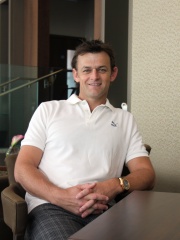
10. Adam Gilchrist (b. 1971)
With an HPI of 39.63, Adam Gilchrist is the 10th most famous Australian Cricketer. Her biography has been translated into 27 different languages.
Adam Craig Gilchrist (; born 14 November 1971) is an Australian cricket commentator and former international cricketer and captain of the Australia national cricket team. He was an attacking left-handed batsman and record-breaking wicket-keeper, who redefined the role for the Australia national team through his aggressive batting. Widely regarded as one of the greatest wicket-keeper-batsman in the history of the game, Gilchrist held the world record for the most dismissals by a wicket-keeper in One Day International (ODI) cricket until it was surpassed by Kumar Sangakkara in 2015 and the most by an Australian in Test cricket. Gilchrist was a member of the Australian team that won three consecutive world titles in a row: the 1999 Cricket World Cup, the 2003 Cricket World Cup, and the 2007 Cricket World Cup, along with winning the 2006 ICC Champions Trophy. His strike rate is amongst the highest in the history of both ODI and Test cricket; his 57 ball century against England at Perth in December 2006 is the fourth-fastest century in all Test cricket. He was the first player to have hit 100 sixes in Test cricket. His 17 Test centuries and 16 in ODIs are both second only to Sangakkara by a wicket-keeper. He holds the unique record of scoring at least 50 runs in three consecutive World Cup finals (in 1999, 2003 and 2007). His 149 off 101 balls against Sri Lanka in the 2007 World Cup final is rated one of the greatest World Cup innings of all time. He is one of only three players to have won three World Cup titles. Gilchrist was renowned for walking when he considered himself to be out, sometimes contrary to the decision of the umpire. He made his first-class debut in 1992, his first One-Day International appearance in 1996 in India and his Test debut in 1999. During his career, he played for Australia in 96 Test matches and over 270 One-day internationals. He was Australia's regular vice-captain in both forms of the game, captaining the team when regular captains Steve Waugh and Ricky Ponting were unavailable. He retired from international cricket in March 2008, though he continued to play domestic tournaments until 2013.
People
Pantheon has 36 people classified as Australian cricketers born between 1908 and 1994. Of these 36, 31 (86.11%) of them are still alive today. The most famous living Australian cricketers include Mitchell Johnson, Steve Smith, and Ian Chappell. The most famous deceased Australian cricketers include Don Bradman, Shane Warne, and Bill Brown. As of April 2024, 11 new Australian cricketers have been added to Pantheon including Ian Healy, Mark Waugh, and Justin Langer.
Living Australian Cricketers
Go to all RankingsMitchell Johnson
1981 - Present
HPI: 44.79
Steve Smith
1989 - Present
HPI: 43.58
Ian Chappell
1943 - Present
HPI: 41.97
Allan Border
1955 - Present
HPI: 41.77
Steve Waugh
1965 - Present
HPI: 39.68
Adam Gilchrist
1971 - Present
HPI: 39.63
Ricky Ponting
1974 - Present
HPI: 38.44
Shaun Marsh
1983 - Present
HPI: 38.21
Glenn McGrath
1970 - Present
HPI: 36.99
Matthew Hayden
1971 - Present
HPI: 35.52
Brett Lee
1976 - Present
HPI: 34.92
Ian Healy
1964 - Present
HPI: 34.05
Deceased Australian Cricketers
Go to all RankingsDon Bradman
1908 - 2001
HPI: 74.98
Shane Warne
1969 - 2022
HPI: 47.73
Bill Brown
1912 - 2008
HPI: 43.82
Richie Benaud
1930 - 2015
HPI: 41.82
Phillip Hughes
1988 - 2014
HPI: 39.08
Newly Added Australian Cricketers (2025)
Go to all RankingsIan Healy
1964 - Present
HPI: 34.05
Mark Waugh
1965 - Present
HPI: 33.51
Justin Langer
1970 - Present
HPI: 30.27
Pat Cummins
1993 - Present
HPI: 27.41
Marcus Stoinis
1989 - Present
HPI: 27.26
Nathan Lyon
1987 - Present
HPI: 25.83
George Bailey
1982 - Present
HPI: 25.38
Adam Zampa
1992 - Present
HPI: 24.00
James Faulkner
1990 - Present
HPI: 23.65
Beth Mooney
1994 - Present
HPI: 21.80
Kane Richardson
1991 - Present
HPI: 19.63
Overlapping Lives
Which Cricketers were alive at the same time? This visualization shows the lifespans of the 5 most globally memorable Cricketers since 1700.

